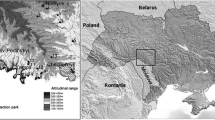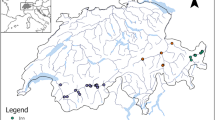Abstract
This paper compares vegetation dynamics at two sites in the savanna landscape of Limpopo National Park (PNL), Mozambique. In order to test the relationship between vegetation cover and hydrology, nutrient availability and disturbance from grazing and fire over the last 1,200 years at local (100 m2) scales, we use palaeoecological data (i.e. pollen assemblages, charcoal abundance, C/N ratio, stable isotopes and herbivore-associated spore abundance). Two pans governed by similar rainfall regimes (on average 600 mm/year) but different hydrologies are compared. Chixuludzi Pan is responsive to the Limpopo River and is more water rich than Radio Pan, which is situated in a dry landscape with little surface water. The analysis suggests that in savannas where water is scarce, the recruitment of woody taxa is constrained mainly by the availability of underground water. In the Radio Pan sequence, the present grassland savanna has been stable throughout the time studied. In contrast, the Chixuludzi Pan savanna landscape where local hydrology, due to the proximity of Limpopo River, allows for a higher water availability the relationship between grass-arboreal pollen suggests a greater variability in vegetation cover, and other factors such as grazing, herbivory and nitrogen availability are important as controlling mechanisms for woody cover. The historical depth of the analysis enables a sub-hierarchy of local scale process to be identified, in this case local hydrology. Local water availability is shown to override the effect of regional rainfall and, in turn, to control the influence of other local scale factors such as nutrients and grazing.








Similar content being viewed by others
References
Aaby B, Digerfeldt B (1986) Sampling techniques for lakes bogs. In: Berglund BE (ed) Handbook of Holocene palaeoecology and palaeohydrology. Wiley, Chichester, pp 181–194
Archibald S, Bond WJ, Stock WD, Fairbanks DHK (2005) Shaping the landscape: fire–grazer interactions in an African savanna. Ecol Appl 15:96–109
Belsky AJ (1995) Spatial and temporal landscape patterns in arid and semi-arid African savannas. In: Hansson L, Fahrig L, Merrian G (eds) Mosaic landscapes and ecological processes. Chapman & Hall, London, pp 31–49
Bennett KD (1996) Determination of the number of zones in a biostratigraphical sequence. New Phytol 132:155–170
Bennett KD (2000) Psimpoll 4.25. (http://www.chrono.qub.ac.uk/psimpoll/psimpoll.html)
Bennett KD, Willis KJ (2001) Pollen. In: Smol JP, Birks HJB, Last WM (eds) Tracking environmental change using lake sediments. Kluwer, Dordrecht, pp 5–32
Bond WJ, Midgley GF, Woodward FI (2003) What controls South African vegetation—climate or fire? S Afr J Bot 69:79–91
Bonnefille R, Riollet G (1980) Pollens des Savannes d’Afrique Orientale. Centre National de la Recherche Scientifique, Paris
Brenner M, Hodell DA, Leyden BW et al (2006) Mechanisms for organic matter and phosphorus burial in sediments of a shallow, subtropical, macrophyte-dominated lake. J Paleoclimatol 35:129–148
Buck CE, Christen JA, James GN (1999) BCal: an on-line Bayesian radiocarbon calibration tool. Internet Archaeol 7. http://bcal.sheffield.ac.uk
Burney DA, Robinson GS, Burney LP (2003) Sporomiella and the late Holocene extinctions in Madagascar. Proc Natl Acad Sci USA 100:10800–10805
Clark JS (1988) Stratigraphic charcoal analysis on petrographic thins sections, application to fire history in northwestern Minnesota. Quat Res 30:81–91
Coughenour MB, Ellis JE (1993) Landscape and climatic control of woody vegetation in a dry tropical ecosystem, Turkana District, Kenya. J Biogeogr 20:383–398
Davis OK (1987) Spores of the dung fungus Sporormiella: increased abundance in historic sediments and before Pleistocene megafaunal extinction. Quat Res 28:290–294
Davis OK, Shafer DS (2006) Sporormiella fungal spores, a palynological means of detecting herbivore density. Palaeogeogr Palaeoclimatol Palaeoecol 237:40–50
Duffin KI, Gillson L, Willis KJ (2008) Testing the sensitivity of charcoal as an indicator of fire events in savanna environments: quantitative predictions of fire proximity, area and intensity. Holocene 18:279–291
Ebersohn C, Eicker A (1992) Coprophilous fungal species composition and species diversity on various dung substrates of African game animals. Bot Bull Acad Sin 33:85–95
Ekblom A, Gillson L (2010a) Fire history and fire ecology of northern kruger (KNP) and Limpopo national park (PNL), southern Africa. Holocene. doi:10.1177/0959683610369499
Ekblom A, Gillson L (2010b) Dung fungi as indicators of past herbivore abundance, Kruger and Limpopo National park. Palaeogeogr Palaeoclimatol Palaeoecol 296:14–27
Faegri K, Iversen J (1992) Textbook of pollen analysis. Chichester, Wiley
FAO (2004) Drought impact mitigation and prevention in the Limpopo River Basin. A situation analysis. FAO Subregional Office for Southern and East Africa, Harare
Finsinger W, Tinner W (2005) Minimum count sums for charcoal-concentration estimates in pollen slides, accuracy and potential errors. Holocene 15:293–297
Fulco L, de Kroon H, Prins HHT, Berendse F (2001) Effects of nutrients and shade on tree–grass interactions in an East Africa savanna. J Veg Sci 12:579–588
Gillson L (2004) Evidence of hierarchical patch dynamics in an east African savanna? Landscape Ecol 19:883–894
Gillson L, Duffin KI (2007) Thresholds of potential concern as benchmarks in the management of African savannahs. Philos Trans R Soc Lond 362:309–319
Gillson L, Ekblom A (2009a) Untangling anthropogenic and climatic influence on riverine forest in the Kruger National Park, South Africa. Veg Hist Archaeobot 18:171–185
Gillson L, Ekblom A (2009b) Phase and transition in savannas, nitrogen ecology, plant available moisture and fire as drivers and responders in ecosystem change. Ecosystems 12:1189–1203
Graf MT, Chmura GL (2006) Development of modern analogues for natural, mowed and grazed grasslands using pollen assemblages and coprophilous fungi. Rev Palaeobot Palynol 141:139–149
Higgins S, Bond WJ, Trollope WS (2000) Fire, resprouting and variability, a recipe for grass-tree coexistence in savanna. J Ecol 88:213–229
Holmgren K, Karlén W, Lauritzen SE et al (1999) A 3000-year high-resolution stalagmite-based record of palaeoclimate for northeastern South Africa. Holocene 9:295–309
Holmgren K, Tyson PD, Moberg A, Svanered O (2001) A preliminary 3000-year regional temperature reconstruction for South Africa. S Afr J Sci 97:49–51
Holmgren K, Lee-Thorpe J, Cooper GRJ et al (2003) Persistent millennial-scale climatic variability over the past 25, 000 years in Southern Africa. Quat Sci Rev 22:2311–2326
Huffman TN (2008) Climate change during the iron age in the Shashe-Limpopo basin, southern Africa. J Archaeol Sci 35:2032–2047
Jacobsen GL, Bradshaw RHW (1981) The selection of sites for paleovegetational studies. Quat Res 16:80–96
Jarzen DM, Elsik WC (1986) Fungal palynomorphs recovered from recent river deposits, Luangwa Valley, Zambia. Rev Palaeobot Palynol 10:35–60
Jeltsch F, Weber GE, Grimm V (2000) Ecological buffering mechanisms in savannas, a unifying theory of long-term tree-grass coexistence. Plant Ecol 161:161–171
Lee-Thorp JA, Holmgren K, Lauritzen S et al (2001) Rapid climate shifts in the southern African interior throughout the mid to late Holocene. Geophys Res Lett 28:4507–4510
Levick S, Rogers K (2008) Patch and species specific responses of savanna woody vegetation to browser exclusion. Biol Conserv 141:489–498
Maher LJ Jr (1981) Statistics for microfossil concentration measurements employing samples spiked with marker grains. Rev Palaeobot Palynol 32:153–191
Marinova E, Atanassova J (2006) Anthropogenic impact on vegetation and environment during the Bronze Age in the area of Lake Durankulak, NE Bulgaria, pollen, microscopic charcoal, non-pollen palynomorphs and plant macrofossils. Rev Palaeobot Palynol 141:165–178
McCormack FG, Hogg AG, Blackwell PG et al (2004) SHCal04 Southern Hemisphere Calibration 0–1000 cal BP. Radiocarbon 46:1087–1092
McLauchlan KK, Craine JM, Oswald WW et al (2007) Changes in nitrogen cycling during the past century in a northern hardwood forest. Proc Natl Acad Sci USA 104:7466–7470
Meyers PA (2003) Application of organic geochemnistry to paleolimnological reconstructions, a summary of examples from the Laurentian Great Lakes. Org Geochem 34:261–189
Meyers PA, Lallier-Vergès E (1999) Lacustrine sedimentary organic matter records of late Quaternary paleoclimates. J Paleolimnol 21:345–372
Mills AJ, Fey MV (2005) Interactive response of herbivores, soils and vegetation to annual burning in a South African savanna. Austral Ecol 30:435–444
Mitchell P (2003) The archaeology of Southern Africa. Cambridge University press, Cambridge
Pickett S, Kolasa J, Armesto J, Collins S (1989) The ecological concept of disturbance and its expression at various hierarchical levels. Oikos 54:129–136
Prentice C (1985) Pollen representation, source area, and basin size, toward a unified theory of pollen analysis. Quat Res 23:76–85
Raper D, Bush M (2009) A test of Sporormiella representation as a predictor of megaherbivore presence and abundance. Quat Res 71:490–496
Robbins JA, Herche LR (1993) Radiochemical limnology, models and uncertainty in 210Pb dating of sediments. Verh Int Ver Limnol 25:217–222
Robinson GS, Burney LP, Burney DA (2005) Landscape palaeoecology and megafaunal extinction in southeastern New York State. Ecol Monogr 75:295–315
Sankaran M, Ratnam J, Hanan NP (2004) Tree grass coexistence in savannas revisited, insights from an examination of assumptions and mechanisms invoked in existing models. Ecol Lett 7:480–490
Sankaran M, Hanan NP, Scholes RJ et al (2005) Determinants of woody cover in African savannas. Nature 438:846–849
Scholes RJ, Archer RS (1997) Tree-grass interactions in savannas. Annu Rev Ecol Syst 28:517–544
Scholes RJ, Bond WJ, Eckhardt HC (2003) Vegetation dynamics in the Kruger ecosystem. In: du Toit JT, Rogers KH, Biggs HC (eds) The Kruger experience. Ecology and management of savanna heterogeneity. Island Press, Washington, pp 242–262
Scott L (1982) Late quaternary fossil pollen grains from the Transvaal, South Africa. Rev Palaeobot Palynol 36:241–278
Stockmarr J (1971) Tablets with spores used in absolute pollen analysis. Pollen Spores 13:614–621
Talbot MR, Lærdal T (2000) The late Pleistocene-Holocene paleolimnology of Lake Victoria, East Africa, based upon elemental and isotopic analyses of sedimentary organic matter. J Paleolimnol 23:141–164
Tyson PD, Preston Whyte RA (2000) The weather and climate of Southern Africa. Oxford University Press, Oxford
Tyson PD, Karlén W, Holmgren K, Heiss GA (2000) The Little Ice Age and medieval warming in South Africa. S Afr J Sci 96:121–126
Tyson PD, Odada EO, Partridge TC (2001) Late quaternary environmental change in Southern Africa. S Afr J Sci 97:139–150
Urban D, O’Neill RV, Shugart HH Jr (1987) Landscape ecology. A hierarchical perspective can help scientists understand spatial patterns. Bioscience 37:119–127
van Geel B, Aptroot A (2006) Fossil ascomycetes in quaternary deposits. Nova Hedwig 82:313–329
van Geel B, Hallewas DP, Pals JP (1983) A late Holocene deposit under the Westfriese Zeedijk near Enkhuizen (Prov. of N-Holland, The Netherlands), palaeoecological and archaeological aspects. Rev Palaeobot Palynol 38:269–335
van Geel B, Buurman J, Brinkkemper O, Schelvis J, Aptroot A, van Reenen G, Hakbijl T (2003) Environmental reconstruction of a Roman Period settlement site in Uitgeest (The Netherlands), with special reference to coprophilous fungi. J Archaeol Sci 30:873–883
van Langevelde F, van de Vijver CADM, Kumar L, van de Koppel J, de Ridder N, van Andel J, Skidmore AK, Hearne JW, Stroosnejder L, Bond WJ, Prins HT, Rietkerk M (2003) Effects of fire and herbivory on the stability of savanna ecosystems. Ecology 84:337–350
van Wilgen BW, Govender N, Biggs HC, Ntsala D, Funda XN (2004) Response of savanna fire regimes to changing fire management policies in a large African National Park. Conserv Biol 18:1533–1540
Wild H, Fernandes A (1968) Vegetation map of the flora Zambesiaca area, supplement. Flora Zambesiaca. The Government Printer, Salisbury
Wu J (1999) Hierarchy and scaling: extrapolating information along a scaling ladder. Can J Remote Sens 25:367–380
Acknowledgements
The work was sponsored by the Andrew W. Mellon foundation. The management of Limpopo National Park aided with logistics in the Limpopo Park, particularly William Swanepoel and our field guide Guillermo Maleluke, whose botanical and ecological knowledge has been important in shaping the understanding of the PNL landscape. Peace Parks Foundation has kindly provided GIS coverage for PNL. An acknowledgement goes also to Dr Michel Notelid who assisted during the 2006 fieldwork. We are also grateful to Kathy Willis and the researchers and students at Long-Term Ecology Laboratory, University of Oxford, for laboratory facilities and stimulating debate.
Author information
Authors and Affiliations
Corresponding author
Rights and permissions
About this article
Cite this article
Ekblom, A., Gillson, L. Hierarchy and scale: testing the long term role of water, grazing and nitrogen in the savanna landscape of Limpopo National Park (Mozambique). Landscape Ecol 25, 1529–1546 (2010). https://doi.org/10.1007/s10980-010-9522-x
Received:
Accepted:
Published:
Issue Date:
DOI: https://doi.org/10.1007/s10980-010-9522-x




